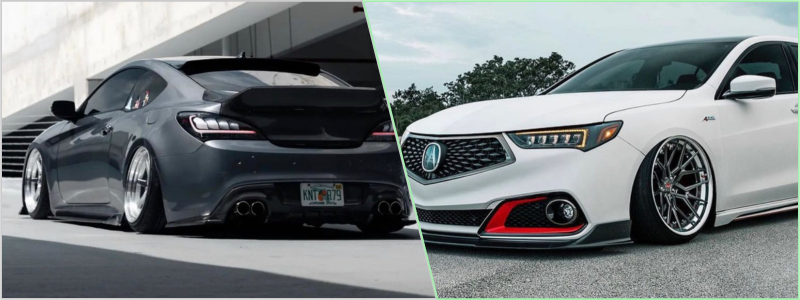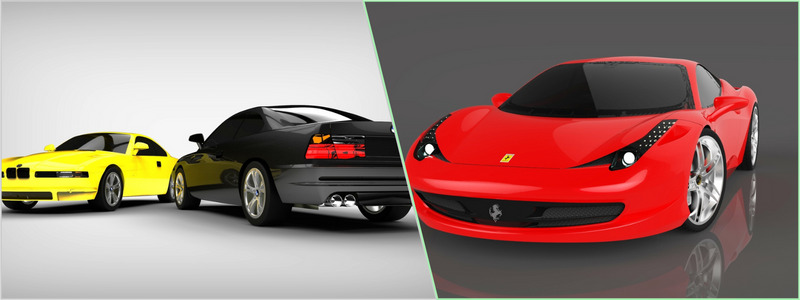Car companies spend enormous amounts of money on developing new automotive design models. An automaker typically needs a year to create a one-off concept, and it may take several years if the prototype is intended to reach the production line. Product modeling design services for a one-off automotive design model costs around $10 million. It can be more expensive if it is an all-new vehicle on an entirely new platform with an all-new powertrain without using anything from the previous model.
The automotive design process includes hundreds of automotive designers and engineers split into numerous small teams to work on specific design elements. For example, a group of highly specialized automotive engineers focuses on the drivetrain, and another team builds the control system; some groups make sure the model complies with government regulations, and a different team is responsible for the suspension design.
RELATED: CAD automotive design – when driving becomes personal
Automotive designer payrate
Given the latest available data from the U.S. BLS, the average annual wage for automotive designers (categorized under the industrial designer occupation) is $77,030, or a rate of around $37 per hour. More than 29,300 automotive designers are currently employed all across the country. Most (37%) hold jobs in the manufacturing sector, and only 13% work in specialized design services. Self-employed design professionals contribute 3% to the total employment.
What do automotive designers do?
Automotive designers and engineering companies work together to devise the best possible solution to every technical challenge in development. They test car components for performance, durability, fuel mileage, aerodynamics, and safety compliance. It may take dozens of tests and design tweaking for one specific automotive component until the designers get it right and send it to another series of analyses.
Technical issues are not the only concern. As designers, they are expected to tap into both scientific and artistic know-how on the job. Besides developing a car that works, automotive designers also have to consider aesthetic factors. The usability aspect and the financial feasibility of the design are crucial points to consider.
RELATED: How much do mechanical engineer services typically charge for rates & firms?
The core duties of automotive designers include the following:
- Sketch vehicle design ideas based on principles of aerodynamics and efficiency
- Develop the sketches into virtual models on a computer for visualization purposes
- Work with mechanical engineers to evaluate the technical feasibility of the design
- Use the virtual models to create multiple versions or iterations of the same concept
- Create physical mock-ups, usually scaled-down replicas, to showcase the exterior design
- Research materials and determine the manufacturing requirement of a fully-functioning prototype
- Evaluate the performance, usability, function, and safety of the vehicle
While the vast majority of concept cars from every automaker never reached the production line, quite a handful fell into the hands of consumers from time to time. Cars like the Ford Bronco, the Audi TT, the Fisker Karma, and the Nissan GT-R are faithful to the concept developed by their respective companies or the automotive designers working for them. A concept car that goes to the production line and becomes popular is a testament to the designers’ meticulous research into the feasibility and marketability of the product.
Automotive design experts always have discussions with other professionals like market research analysts, material scientists, manufacturers, and industrial engineers to determine whether any particular design is technically and financially viable. Inputs from automotive professionals and feedback from potential customers are the foundation for developing a concept car.
RELATED: Get your engine revving: 5 automotive CAD designs
Sometimes, a concept car is a theoretical approach to automotive design. The vehicle may look impressive with many exciting design features like a wooden floor, an interactive AI-powered driving system, or an extendable wheelbase. Still, the designers know it will never move toward production – at least not anytime soon. The concept is intended to showcase what the company is capable of and what is technically possible, especially when a car doesn’t have to meet road-legal requirements.

Virtual test using CAD-based simulation
Modern automotive designers use CAD software to develop initial sketches into a 3D visualization of the finished concept. Computers can simulate almost every engineering and performance test required even before a physical prototype exists. Virtual simulations and evaluations might be sufficient for a one-off model, but a series of real-world tests remains indispensable for production concept design services.
Either way, automotive designers must be there to gather data, compile analysis reports, and improve the car based on the findings. Especially for a production car, the tests may expose the vehicle to wear and tear (exterior, interior, engine, electric systems, infotainments, etc.), extreme weather conditions, neglect, excessive usage, and safety or crash test, to name a few. A CAD-based simulation can generate all the information but can never replace a real-world evaluation. A carmaker will not want to rely on a digital test to develop a production car; considering the enormous investments, it is risky.
RELATED: 10 Awesome vehicle designs from the Cad Crowd gallery
The workspaces of automotive designers typically are office environments with whiteboards for brainstorming, computers with advanced 3D modeling software, meeting room, pencils, and sketchbooks. They may not need to leave the room to design a concept car. When developing a road-legal production vehicle, they must visit production facilities, wind tunnels, and test tracks.
The big investment
The development process of a concept car – intended to go to production – involves more than the technical perspective of engineers and the aesthetic approach of 3D modeling designers. Developing a vehicle that will not appeal to consumers makes little sense. Furthermore, the price tag for the final production model should not exceed what buyers can afford.
In addition to the automotive designers’ salary, the investment also goes to compensate the engineers, purchasing analysts, accountants, assembly line workers, marketing professionals, part manufacturers, and a range of third-party consultants working on the development. A large portion of the money goes into support staff for IT, human resources, and executive decision-makers. Of course, every automaker must also consider the basic operational cost (overhead).
RELATED: Cad Crowd’s automobile design freelancers are top notch
Some insights
According to Bruce Belzowski, the managing director of Automotive Future Research Group, a car is an outstandingly sophisticated piece of machinery with hundreds of thousands of parts working together to form a reliable means of transportation. If one thinks about it, a car is just bits of metal doing their function in harmony. Also, the design process must ensure the vehicle will work for a reasonable number of years before the user moves to another model. A car is not supposed to be a disposable item.
Ford Motor Company’s Head of North America Product Communications, Said Deep, argues that a car is more challenging to design than even airplanes to the extent of the users’ understanding. Airplane operators and maintenance technicians are trained to do their jobs and have in-depth knowledge of the vehicle. On the other hand, everybody can drive a car; not all can perform basic maintenance procedures, let alone repair the transmission or reconfigure the ECU.
When an automotive designer works on a new concept, guesswork shouldn’t be involved. The design has to be feasible to produce with the existing assembly line equipment, and it must generate profits for the company. Once the design is “locked” or the physical parameter of the car has been established, the designers then collaborate with the engineers to determine performance limitations, ergonomics, and overall serviceability.

Why make concept cars at all?
Concept cars often introduce radical stylings and state-of-the-art drivetrain systems. They are typically displayed at auto shows, alongside actual production cars, to gauge reactions from customers, industry professionals, and the media.
RELATED: Top 101 engineering and mechanical design firms in the United States
Most concept cars are not road-legal, and companies must undergo significant overhauls to meet government regulations to turn them into production models. Automakers build concept cars for two main reasons:
- Demonstrate technical proficiency: many automakers develop concept cars only to showcase their design and engineering capabilities. The concepts tell the world how companies can build vehicles with exotic materials and impressive performance figures. Since the technologies are still too expensive to mass-produce, the companies incorporate them into a non-production model.
- Measure public interest: automakers also develop a concept to indicate a shift of design language or introduce a new range of vehicles in the lineup. The cars are actual prototypes instead of concepts and can be mass-produced. However, the companies want to make sure the design gains enough attention from the public before the market launch.
Generating hype for the sake of mere media exposure is not uncommon in the automotive industry. With enough buzz from the media, the companies take the front page of the coverage for an additional marketing advantage. Even if the concepts are not drivable (or drivable but not road-legal), they become the gateway to attract customers to the existing line of vehicles.
RELATED: How is 3D product rendering and visualization used by manufacturers and retailers?
Modern concept cars are also used to demonstrate future technologies. Electric cars, autonomous AI, or hydrogen fuel cell vehicles took their starts into the automotive industries as concepts. The technologies are already here, but automakers will only continue developing concepts until they generate enough media coverage and discussions among enthusiasts.
How Cad Crowd can assist
We have reinvented the field of automotive design. We stand apart from conventional automotive design firms by offering a complete range of design, product development, prototyping, and manufacturing services from one convenient location. Whether you need a freelance engineer or a team of product development professionals, our roster of designers is ready to help.
